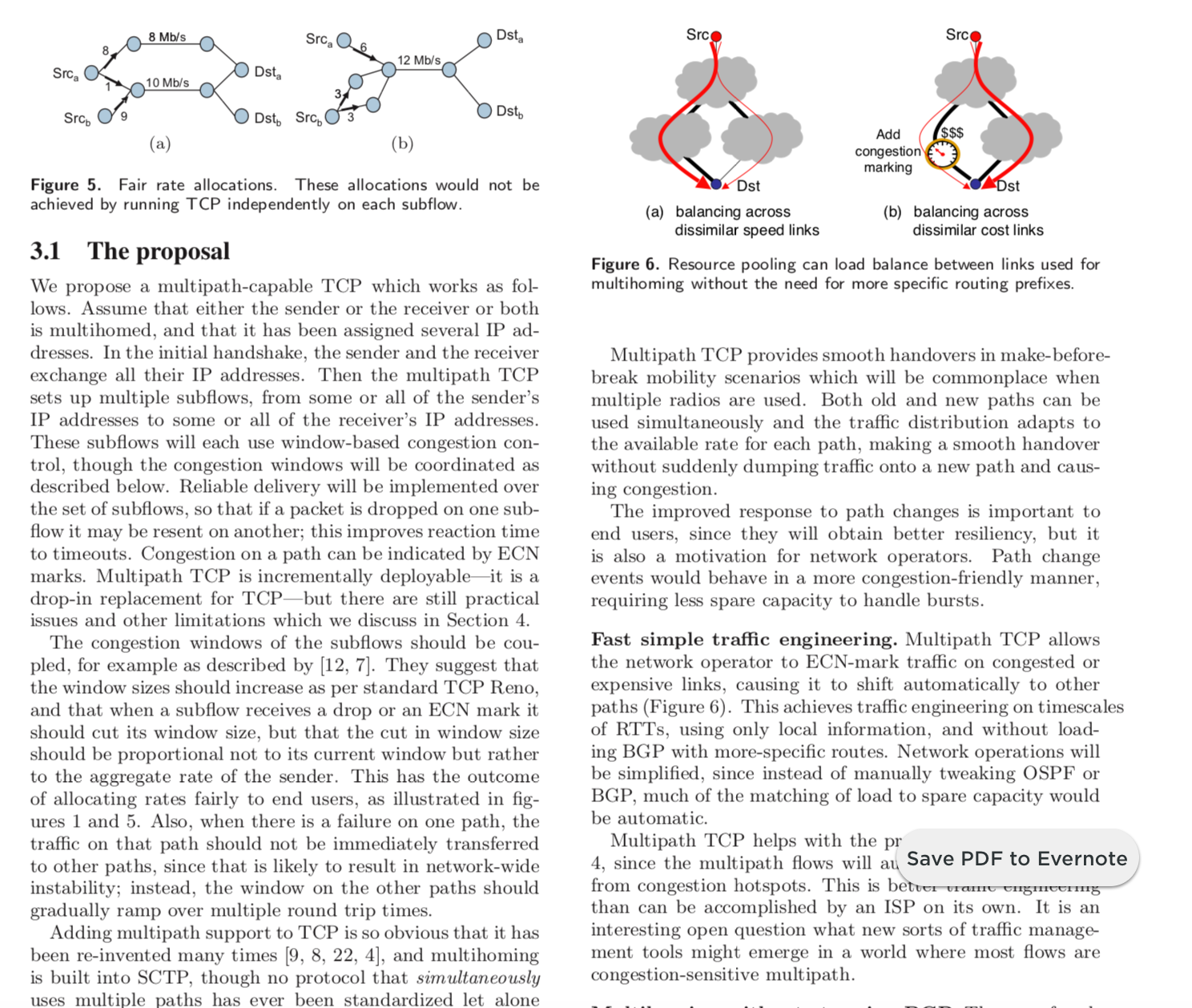The Multipath TCP foundations
When looking at a new protocol, it is also interesting to start by reading the initial motivations for its design. The initial design of Multipath TCP was heavily influenced by the Resource Pooling Principle written by Damon Wischick, Mark Handley and Marcelo Bagnulo [WHB08] and published as an editorial in SIGCOMM’s Computer Communication Review. Since the early days of computer networks, statistical multiplexing, failure resilience and load balancing have played a key role in enabling networks to carry a growing amount of traffic. However, many of the techniques that are used today were designed under the assumption that they needed to have a local impact. Many of these designs missed the opportunity of considering the problem of pooling all the available resources as an end-to-end problem.
Multipath TCP, by enabling endhosts to efficiently use different paths to exchange packets was designed to solve one aspect of this problem. Content Distribution Networks and the more recent Mobile Edge Computing approaches also contribute to this overal goal of improving the sharing of all the available network resources. The initial design for Multipath TCP is briefly sketched on page 3 :

Later on this page, Damon Wischick, Mark Handley and Marcelo Bagnulo provide an interesting comment about the design of Multipath TCP :
Adding multipath support to TCP is so obvious that it has been re-invented many times [Hui95], [HS02], [RA04], [DWPW07], and multihoming is built into SCTP, though no protocol that simultaneously uses multiple paths has ever been standardized let alone widely deployed. Why is there not more multipath at the transport layer? Perhaps because it has not been understood that multipath lets end systems solve network-wide resource pooling problems, and because the issues with cur- rent mechanisms are only now becoming pressing enough to fix.*
This paragraph clearly suggests that one of the objectives of Multipath TCP will be to put the endhosts in control for the selection and the utilisation of multiple end-to-end paths to reach a given destination. In fact, Resource Pooling Principle could be considered as a natural extension of Saltzer, Reed and Clark’s End-to-end arguments in system design paper [SRC84] when considering resource utilisation.
The paper ends with one definition and two observations that remain valid today:
Definition. Resource pooling means making a collection of networked resources behave as though they make up a single pooled resource. The general method of resource pooling is to build mechanisms for shifting load between various parts of the network
Observation 1. Resource pooling is often the only practical way to achieve resilience at acceptable cost.
Observation 2. Resource pooling is also a cost-effective way to achieve flexibility and high utilization.
References
| [DWPW07] | Yu Dong, Dingding Wang, Niki Pissinou, and Jian Wang. Multi-path load balancing in transport layer. In Next Generation Internet Networks, 3rd EuroNGI Conference on, 135–142. IEEE, 2007. |
| [HS02] | Hung-Yun Hsieh and Raghupathy Sivakumar. Ptcp: an end-to-end transport layer protocol for striped connections. In null, 24. IEEE, 2002. |
| [Hui95] | C Huitema. Multi-homed tcp. draft-huitema-multi-homed-01. Internet Engineering Task Force (IETF), 1995. |
| [RA04] | Kultida Rojviboonchai and Hitoshi Aida. An evaluation of multi-path transmission control protocol (m/tcp) with robust acknowledgement schemes. IEICE transactions on communications, 87(9):2699–2707, 2004. |
| [SRC84] | J. Saltzer, D. Reed, and D. Clark. End-to-end arguments in system design. ACM Transactions on Computer Systems (TOCS), 2(4):277–288, 1984. |
| [WHB08] | D. Wischik, M. Handley, and M. Bagnulo. The resource pooling principle. SIGCOMM Comput. Commun. Rev., 38(5):47–52, September 2008. URL: http://doi.acm.org/10.1145/1452335.1452342, doi:10.1145/1452335.1452342. |